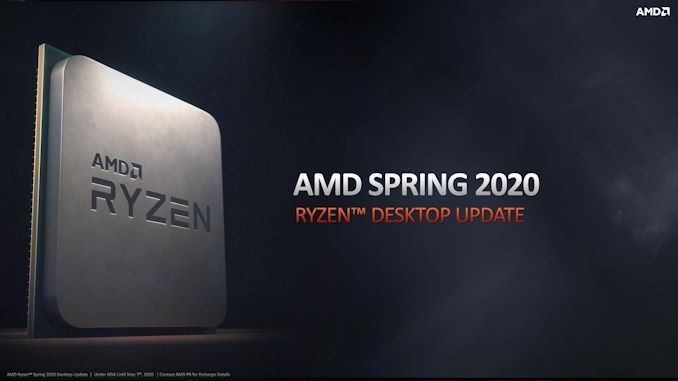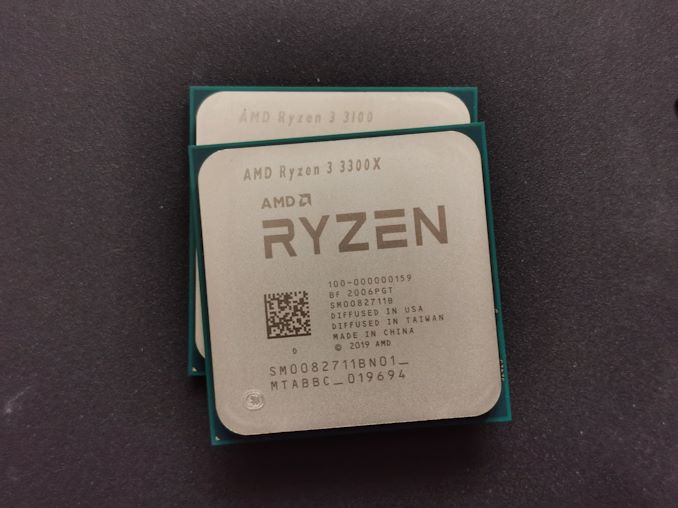The AMD Ryzen 3 3300X and 3100 CPU Review: A Budget Gaming Bonanza
by Dr. Ian Cutress on May 7, 2020 9:00 AM ESTThe Battering Ram of Time
A wouldn’t say a lot, but at least some discussion has been permeating through the airwaves since the Ryzen 3000 desktop launch as to what AMD was going to do in its sub-$200 space. Not having a latest generation product in a very active part of the market was missing from the portfolio, but initially AMD was happy for its previous generation CPUs and APUs to fill that role.
There were two schools of thought. The first is that AMD would launch lower core count CPUs, despite having a supposedly high yielding chiplet design that was going straight into its highest margin server product portfolio. Building a low core count chiplet design also incurs the added cost of bringing a chiplet and an IO die together in packaging, further decreasing margins. It seemed unlikely at the time.
The second school of thought would be that AMD would populate this part of the market with desktop versions of the Ryzen 4000 mobile APUs. These monolithic parts had integrated graphics, and would very likely easily scale from 45 W to 65 W for the desktop. Like previous APUs there would only be 8 PCIe lanes for external graphics, but for this generation also only PCIe 3.0 due to how the mobile APUs were powered.
Personally I assumed the second one, and that AMD would ignore the CPUs and go straight in for the APUs. I was perhaps unprepared for the apparent success of AMD’s mobile chips in the laptop space. We’ve reviewed the ASUS Zephyrus G14, a true flagship AMD notebook, and the Acer Swift 3, offering mind-bending performance and quality for the price. AMD is promoting 100+ design wins on Ryzen Mobile in 2020, global pandemic permitting, and the OEMs are jumping on the bandwagon it seems.
As we’ve shown in the review, this means that we get some CPUs. The Ryzen 3 3300X and Ryzen 3 3100 are odd elements to the Ryzen family, especially the 3100 with its awkward CCX and core configuration, but both parts offer a lot of performance for their pricing. At $120 and $99 respectively, using AMD’s latest Zen 2 microarchitecture and the power efficient 7nm TSMC process, AMD is defining a new baseline in budget performance.
This is personified in very much in comparing the AMD Ryzen 3 3300X to Intel’s flagship consumer processor from 2017.
Three years and four months ago at CES, Intel launched to great fanfare its Kaby Lake processor family, with the Core i7-7700K sitting atop of the stack. This quad core Skylake-based chip offered frequency bumps from the previous gen, and better gaming performance in a 91 W package. Its 4.2 GHz base frequency, 4.5 GHz turbo frequency, DDR4-2400 memory support and 16 PCIe 3.0 lanes were the talk of the down. All this could be yours for $350.
Then push forward a short time to today, and the Ryzen 3 3300X. This is also a quad core processor, built with Zen 2 cores at a lower frequency: only 3.8 GHz base and 4.3 GHz turbo. There’s faster memory in DDR4-3200, more and faster 24 PCIe 4.0 lanes, and is rated only at 65 W. For almost one third of the price, at $120.
Cue the roundup results.
| Benchmark Comparison Ryzen 3 3300X vs i7-7700K at 100% |
|||
| AnandTech | Ryzen 3 3100 |
Ryzen 3 3300X |
Core i7-7700K |
| Web | 121% | 138% | 100% |
| System | 99% | 112% | 100% |
| Encoding | 105% | 115% | 100% |
| Rendering | 98% | 111% | 100% |
| Synthetics | 103% | 110% | 100% |
| Dwarf Fortress | 86% | 95% | 100% |
| Legacy | 96% | 105% | 100% |
| Gaming | 99% | 105% | 100% |
I’m pretty sure prices of used Kaby Lake CPUs are about to crash. They’re going to have to fall a long, long way though.
It's at this time I should point out that Intel obviously has newer quad cores on offer. The 9th Generation Core i3 parts are quad core with no hyperthreading, but still running a variant of the Skylake microarchitecture, albeit at a higher frequency. The Core i3-9100 for example is a 4C/4T part with a base of 3.6 GHz and turbo of 4.2 GHz, and a TDP of 65W, for $120. It still only has PCIe 3.0 and DDR4-2400 however, so it would likely perform worse than the i7-7700K. Even with this, Intel's ability to provide enough stock of these low-end parts, depending on your location, is questionable as previously mentioned. Case in point: the comapny never even made it as far as sampling any of the 9th Generation i3 parts for review.
Intel has announced the 10th Generation Comet Lake processors, coming later this month, and the Core i3 parts there will offer hyperthreading. The Core i3-10100 is a 4C/8T part with a 3.6 GHz base and a 4.3 GHz turbo, with a 65 W TDP for $120. It still only has PCIe 3.0, but supports DDR4-2666, compared to AMD supporting PCIe 4.0 and DDR4-3200. When these are available at retail, we should put it up against the 3300X to see who wins.
All that being said, AMD still has two issues to sort out with the new Ryzen 3 parts. The idle power seems high at 18 W, and B550 motherboards need to exist to make these Ryzen 3 processors more attractive for system builds. The latter should come around soon, and we’ll have additional coverage there.
At the end of the day, if you are the sort of person that enjoys waiting a couple of years to get games 95% off on Steam, the 3300X is your processor. Those AAA titles are calling.












249 Comments
View All Comments
Spunjji - Monday, May 11, 2020 - link
You missed out on what Userbenchmark would add. Luckily most of us know the answer is "nothing".I'm now pretty convinced that you're a Deicidium sockpuppet.
Spunjji - Monday, May 11, 2020 - link
Oh for crying out loud. The first two posts in the comments wasted on a feckless simpleton blubbering that this site doesn't do the exact same things every other site does.Guess what laddoo - that's the point.
twizzlebizzle22 - Thursday, May 7, 2020 - link
Bit disappointed with the CPU selection used in this article.Thought it might be interesting to see how it fares against the 1600AF or R5 3600. Different CPUs which people might be considering if they're worth the extra.
amrnuke - Thursday, May 7, 2020 - link
Exactly. I'd have loved to see it up against the i3 9100F, 9400F. Comparison to the 3600 and 1600AF would be very welcome given the 1600AF's price range and 3300X vs 3600 would be very interesting from a gaming standpoint.DanNeely - Thursday, May 7, 2020 - link
None of those CPUs are in Bench, so Ian doesn't have any of them to test. The original 1600 is present for the older benchmarks, but not the newer ones. I wouldn't expect many CPUs to be run on the new ones until all of them are finished and ready to go in order to minimize the amount of time spent dis/reassembling test systems.flyingpants265 - Thursday, May 7, 2020 - link
Bench is terrible, it's missing way too many options. Most common problem I run into is when I'm trying to compare an older card (7870 or gtx660 or something) to a newer card, and they are just missing from the list. Just needs to be expanded and improved.0ldman79 - Thursday, May 7, 2020 - link
That's because the data sets don't overlap.They were run with different CPU, OS, etc...
I'd like for there to be a checkbox that says "these aren't scientific, you can compare incomplete, incorrect data at your own risk" etc, but there's a reason they aren't in the same listing; they're not the same.
Zizy - Friday, May 8, 2020 - link
The problem is that such data is often very misleading. By far the most important issue: there are many drivers touting >10% speedup in game X. You might as well guess which GPU is faster if they end up very close over many generations. Heck, simple "the new GPU has X% more CU and Y% higher frequency vs old one" is likely to lead to a better estimate than trying to correct for all that mess.regsEx - Thursday, May 7, 2020 - link
Worst part in the test is the RAM. That set of 3200C14 memory is very expensive - $160. That making entire build pointless. For that money you can get 32 GB kit with 6-core Core i3 10400.b0rnslippy - Thursday, May 7, 2020 - link
Oh Ian doesn't have them in Bench.. How convenient for Ian. Ehem, "Dr" Ian, sorry.